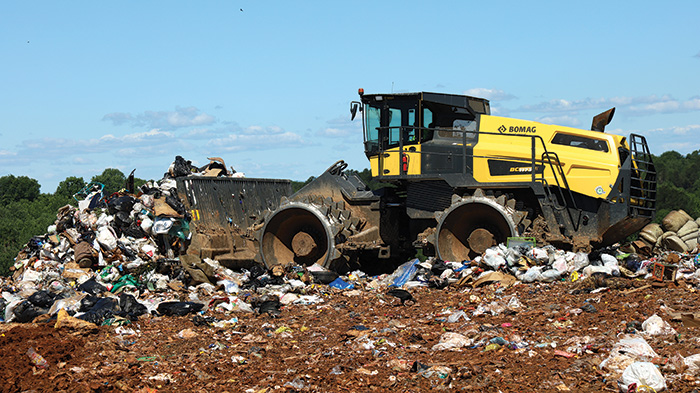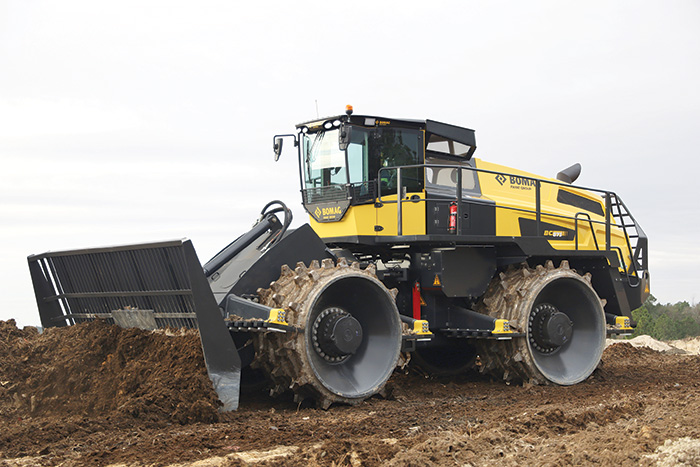Effective compactors not only excel in performance, but also prioritize safety, cost-effectiveness, and environmental stewardship, making them the preferred choice in the industry for achieving optimal compaction results.
By Ruben Garcia
In the contemporary landscape, landfill machinery assumes a pivotal role in sustaining the operational lifespan of landfills. With the rapid increase in waste disposal rates, airspace is diminishing at an alarming rate, accentuating the criticality of efficient waste management. Over time, refuse compactors have undergone significant advancements, evolving into sophisticated tools designed to optimize compaction and conserve precious airspace. This progression not only enhances operational efficiency, but also yields economic and environmental benefits by extending the service lifespan of landfill sites, aligning with sustainable waste management practices.
What Features Should You Prioritize for an Efficient Landfill Compactor?
Efficient landfill compaction starts with airspace conservation. The goal is to prolong the site’s lifespan to continue revenue generation based on processed tonnage. Achieving higher compaction density extends the landfill’s lifespan. When determining the size of the landfill site and its desired lifespan, it is essential to consider operational weight as a crucial factor.
Airspace within a landfill is its most valuable asset. This non-monetary resource has the potential to significantly boost the financial performance of the landfill. The larger the airspace, the more valuable this asset becomes, leading to greater potential for long-term financial gains.
So, how can landfill compactors achieve greater compaction values, resulting in a longer service life? We believe that by integrating premium features into refuse compactors, it can impact airspace conservation. Here are some standout features:
- Airspace conservation capabilities: Integration of new technologies in design, such as machine degree of oscillation and articulation, stability, wheel design, machine weight distribution to the compaction wheels, and absence of a central drive line.
- Wheel performance enhancements: Wheel design using two cast materials, polygonal rings, offset wheels, tooth design, number of teeth per wheel, and inclusion of scrapers and wire cutters.
- Operational weight diversity: Refuse compactors are available in different wheel classes suitable for any landfill size. From those designed to compact an average of 500 tons of MSW per day, to others capable of compacting an average of 1,200 tons of MSW per day.

The Progression of Landfill Compactors: What Types of Technologies/Features are Included to Make them More Efficient than Ever?
Landfill equipment has come a long way since the days of relying on standard dozers and wheel loaders for compaction. Today, dedicated landfill machines are meticulously designed to cater to the specific requirements of landfill owners. This evolution has centered on enhancing engine power packs, implementing hydrostatic transmission systems, and refining wheel designs.
Refuse compactors are meticulously crafted with a specific purpose in mind. Distinctly, engineered and rigorously tested, sanitary landfill compactors are tailored to excel in the demanding conditions found on landfill sites. With an emphasis on high pushing and compaction power, as well as exceptional traction, ensure that your compactors meet the essential requirements of the job. Look at refuse compactors that are purpose-built for this task—distinct from compactors originating from wheel loaders.
In landfill compaction machines, proven drive systems comprise of liquid-cooled diesel engines and hydrostatic drives. Power generated by the diesel engine is seamlessly transmitted to the compactor wheels through hydrostatic drives. Effective compactor wheels are independently powered by a hydraulic motor equipped with planetary reduction drive, while each travel motor is fueled by its own hydraulic pump. This design incorporates four individual closed hydraulic circuits within the travel system, guaranteeing consistent traction for the wheels under all conditions. Fully hydrostatic machines operate without axles, transmission, or driveshaft, effectively eliminating the risk of wrapping material around moving components. This significant advantage translates into less clean-up time, saving valuable labor hours.
In addition to an exceptional drive system, consider a 30-degree oscillation and articulation joint between the front and rear compaction wheel areas. This innovative design ensures continuous contact of all wheels with the ground, leading to improved machine traction and enhanced compaction performance.

A new compaction wheel design is also available in the industry. It features polygon rings segments alongside premium hardened tips in compaction wheels. As waste material is torn apart by the premium hardened tips, the polygon rings on the wheel go to work, effectively crushing and kneading the fragmented material. This dual action not only compresses the waste, but also expels air from within, resulting in unparalleled compaction efficiency.
A clean wheel is essential for optimal performance. That is why there are two innovative methods to ensure compactors’ wheels always remain free from debris. Each wheel is equipped with scraper bars positioned in front of and behind each wheel. Additionally, a wire cutter system, featuring two wire cutters on each wheel, effectively prevents wrapping materials from causing damage to the final drives. These advanced features not only enhance performance, but also extend the lifespan of equipment. Using scrapers, wire cutters, and polygon rings provides a notable advantage: achieving the highest penetration depth and executing a two-step compaction process with elevated ground pressures in the final stage. The corresponding benefit is the ability to compact layers up to 23 inches (600 mm), leading to the best possible compaction results.
Furthermore, rear wheels are strategically offset from the front ones. This design detail enhances the kneading and compaction effect by ensuring complete surface coverage with each pass. The overlapping wheel patterns effectively reduce the number of overall passes required, and this reduction in passes translates to lower fuel consumption, decreased wear on the machine, and improved efficiency across the board.
What are the Economic and Environmental Benefits of Effective Landfill Compaction?
As previously discussed, achieving maximum compaction with a high air density rating significantly prolongs the lifespan of the landfill site, resulting in economic benefits. The environmental implications are clear as well, as a longer lifespan means slower expansion of additional landfill sites. In the competitive landscape of the compaction industry, fuel savings and powerful engines not only ensure optimal compaction, but also eliminate the need for additional equipment such as dozers and excavators at the landfill site. With fewer machines onsite, operational costs are significantly reduced, including fuel consumption, maintenance expenses, and labor requirements.
Moreover, less machinery on the landfill face increases safety, minimizing the risk of collisions and accidents in the landfill area. Superior compaction capability extends the service life of landfills, contributing to environmental preservation and long-term sustainability. In essence, effective compactors not only excel in performance, but also prioritize safety, cost-effectiveness, and environmental stewardship, making them the preferred choice in the industry for achieving optimal compaction results. | WA
Ruben Garcia is currently the Product Marketing Manager for Soil Compactors at BOMAG, overseeing a range of equipment including single drum rollers, embankment, and refuse compactors. With more than two decades of experience both domestically and internationally, Ruben has honed his expertise in heavy equipment across mining, construction, and the oil and gas sectors. His comprehensive understanding of industry dynamics and commitment to innovation make him a valuable asset in driving product development and market success. He can be reached at [email protected].
